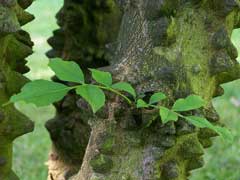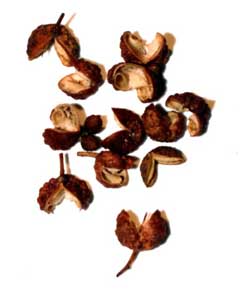 |
|
commons.wikimedia.org/wiki/User:Teacoolish |
 |
|
Translate this page:
Summary
Bloom Color: Red. Form: Rounded, Vase.
Physical Characteristics

 Zanthoxylum_simulans is a deciduous Shrub growing to 4 m (13ft) by 6 m (19ft) at a medium rate.
Zanthoxylum_simulans is a deciduous Shrub growing to 4 m (13ft) by 6 m (19ft) at a medium rate.
See above for USDA hardiness. It is hardy to UK zone 6. It is in flower in June, and the seeds ripen in October. The species is dioecious (individual flowers are either male or female, but only one sex is to be found on any one plant so both male and female plants must be grown if seed is required). . The plant is not self-fertile.
Suitable for: light (sandy), medium (loamy) and heavy (clay) soils and prefers well-drained soil. Suitable pH: mildly acid, neutral and basic (mildly alkaline) soils. It can grow in full shade (deep woodland) semi-shade (light woodland) or no shade. It prefers moist soil.
UK Hardiness Map
US Hardiness Map
Synonyms
Zanthoxylum acanthophyllum. Zanthoxylum argyi. Zanthoxylum podocarpum
Plant Habitats
Edible Uses
The fruit is dried and used as a condiment[46, 61, 105, 177]. A pepper flavour, it is stronger and more pungent than black pepper[183]. It can be used whole or ground into a powder and used as a table seasoning[183]. A light roasting brings out more of the flavour[206]. It is an ingredient of the famous Chinese 'five spice' mixture[206].
References More on Edible Uses
Medicinal Uses
Plants For A Future can not take any responsibility for any adverse effects from the use of plants. Always seek advice from a professional before using a plant medicinally.
Astringent, diaphoretic, emmenagogue[116, 178]. The pericarp is anaesthetic, diuretic, parasiticide and vasodilator[176]. It is used in the treatment of gastralgia and dyspepsia due to cold with vomiting, diarrhoea, abdominal pain, ascariasis and dermal diseases[176]. It has a local anaesthetic action and is parasiticide against the pork tapeworm (Taenia solium)[176]. The pericarp contains geraniol. In small doses this has a mild diuretic action, though large doses will inhibit the excretion of urine[176]. There is a persistent increase in peristalsis at low concentration, but inhibition at high concentration[176]. The leaves are carminative, stimulant and sudorific[147, 218]. The fruit is carminative, diuretic, stimulant, stomachic and tonic[147, 218]. The seed is antiphlogistic and diuretic[218]. A decoction of the root is digestive and also used in the treatment of snakebites[218]. The resin contained in the bark, and especially in that of the roots, is powerfully stimulant and tonic[82].
References More on Medicinal Uses
The Bookshop: Edible Plant Books
Our Latest books on Perennial Plants For Food Forests and Permaculture Gardens in paperback or digital formats.

Edible Tropical Plants
Food Forest Plants for Hotter Conditions: 250+ Plants For Tropical Food Forests & Permaculture Gardens.
More

Edible Temperate Plants
Plants for Your Food Forest: 500 Plants for Temperate Food Forests & Permaculture Gardens.
More

More Books
PFAF have eight books available in paperback and digital formats. Browse the shop for more information.
Shop Now
Other Uses
References More on Other Uses
Cultivation details
Landscape Uses:Border, Massing. Easily grown in loamy soils in most positions, but prefers a good deep well-drained moisture retentive soil in full sun or semi-shade[1, 11, 200]. A plant has been growing well for many years in deep woodland shade at Cambridge Botanical gardens, it was fruiting heavily in autumn 1996[K]. Cultivated for its seed, which is used as a condiment in China[46, 61]. Flowers are formed on the old wood[206]. The bruised leaves are strongly aromatic[245]. Dioecious. Male and female plants must be grown if seed is required. Special Features:Inconspicuous flowers or blooms, Blooms appear periodically throughout the year.
References Carbon Farming Information and Carbon Sequestration Information
Temperature Converter
Type a value in the Celsius field to convert the value to Fahrenheit:
Fahrenheit:
The PFAF Bookshop
Plants For A Future have a number of books available in paperback and digital form. Book titles include Edible Plants, Edible Perennials, Edible Trees,Edible Shrubs, Woodland Gardening, and Temperate Food Forest Plants. Our new book is Food Forest Plants For Hotter Conditions (Tropical and Sub-Tropical).
Shop Now
Plant Propagation
Seed - best sown in a greenhouse as soon as it is ripe in the autumn. Stored seed may requires up to 3 months cold stratification, though scarification may also help[113]. Sow stored seed in a cold frame as early in the year as possible. Germination should take place in late spring, though it might take another 12 months. Prick out the seedlings into individual pots when they are large enough to handle and grow them on in a cold frame for their first winter. Plant them out in early summer. Cuttings of half-ripe wood, July/August in a frame. Root cuttings, 3cm long, planted horizontally in pots in a greenhouse. Good percentage[78]. Suckers, removed in late winter and planted into their permanent positions[113].
Other Names
If available other names are mentioned here
Native Range
TEMPERATE ASIA: China (Anhui Sheng, Zhejiang Sheng, Fujian Sheng, Henan Sheng, Hebei Sheng, Hunan Sheng, Hubei Sheng, Gansu Sheng, Jiangxi Sheng, Jiangsu Sheng, Guangdong Sheng (north), Guizhou Sheng (northeast), Shandong Sheng, Shaanxi Sheng, Qinghai Sheng), Taiwan
Weed Potential
Right plant wrong place. We are currently updating this section.
Please note that a plant may be invasive in one area but may not in your area so it’s worth checking.
Conservation Status
IUCN Red List of Threatened Plants Status :

Growth: S = slow M = medium F = fast. Soil: L = light (sandy) M = medium H = heavy (clay). pH: A = acid N = neutral B = basic (alkaline). Shade: F = full shade S = semi-shade N = no shade. Moisture: D = dry M = Moist We = wet Wa = water.
Expert comment
Author
Hance.
Botanical References
11200
Links / References
For a list of references used on this page please go here
Readers comment